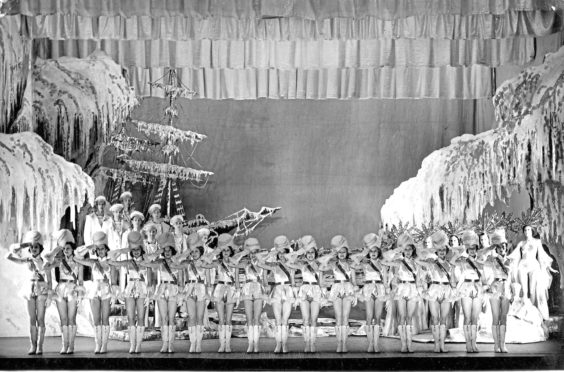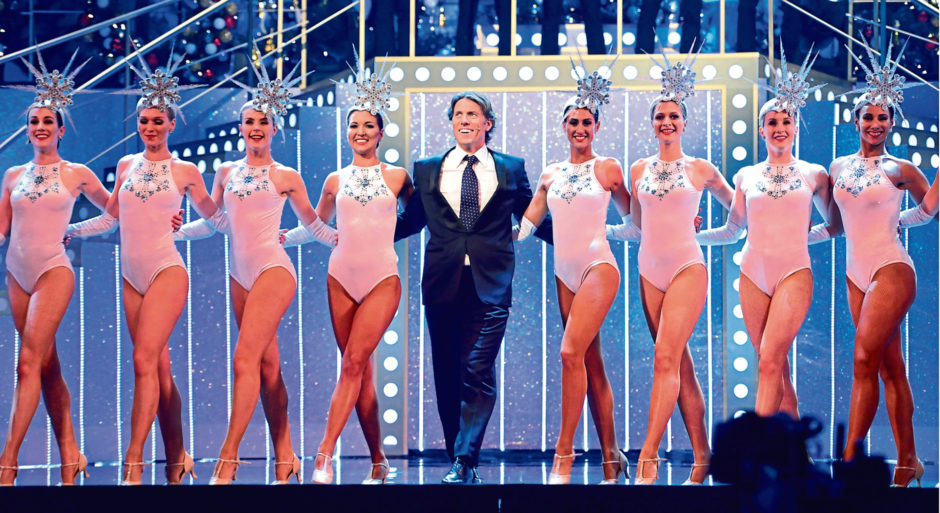
The world’s best loved chorus line – the Tiller Girls – may be heading for a revival in 2020.
Dance entrepreneurs Marina and Martin Blore are hoping to bring back an updated version of the regimented high kickers who, in their prime, boasted 80 separate troupes around the world.
With the blessing of Bernie Tiller, great-grandson of John Tiller, founder of the Tiller Girls, the Blores took over the licensing of the Tiller brand seven years ago, and have already debuted a revival on the John Bishop Christmas TV Special in 2013, featuring a line-up of 16 dancers.
So what prompted the Blores to want to resurrect a light entertainment concept that might seem to some a little out of date?
Marina explains: “I went on a backstage tour of the Radio City Music Hall in New York, where The Rockettes are the main attraction, and the first photograph you see is of The Tiller Girls. I’d never realised that The Rockettes were a direct copy of the Tillers.”
John Tiller was a successful Manchester cotton trader in the late 19th Century who had a passion for the theatre and, in particular, dance. In 1885 he opened a dance school for children in one of his warehouses, providing child performers for the Christmas pantomime at the Comedy Theatre, Manchester, of which he was a director.
Bored with his job in the cotton industry, Tiller became more and more focused on his dance school, drilling his young charges with military precision. In 1890 he was asked to present a quartet of young girls for Robinson Crusoe at the Prince of Wales, Liverpool.
He drilled them until they were perfectly co-ordinated, working them so hard they sometimes had to be carried home by their parents, their feet too blistered to walk.
Clearly John Tiller was a perfectionist, often at the expense of his young dancers. Every movement had to be just so, every turn identical to the dancer next in line. All the reviews for the pantomime commented on the excellence of the young dancers and Tiller made up his mind to pursue the life of a dance teacher and entrepreneur.
By the late 19th Century, Tiller’s precision-trained girls, all the same height and weight, were dancing in ballet and musical performances all over the world. The famous high-kicking routines derived of Tiller dressing them as soldiers on parade, linking arms around each other’s waists as they kicked their legs up in unison.
It was this simple idea that was to make his name a byword for the closely co-ordinated chorus line. He went on to perfect a high-kicking dance he called the Pony Trot he developed for the Folies Bergere in Paris. It was rumoured at the time that it was inspired by his visit to the Lipizzaner Stallion display in Vienna.
Tiller wrote in a 1906 souvenir brochure for his training schools: “The popularity of the Tiller Girls is worldwide. It has been assiduously earned by 20 years of careful tuition – somewhat less strenuous than the traditional method, more apt therefore to induce grace, charm and, above all, spontaneity.
“The note of the Tiller system is to make work pleasant by encouraging a buoyant emulation; to prevent excess, in artistry or conduct, by keeping ardent the spirit of loyalty and good fellowship.”
However pompous he may have been in expressing himself, Tiller’s ethos laid down the ground rules for several generations of chorus lines, so popular in the first half of the 20th Century.
Tiller first sent a troupe of dancers to America in 1899, performing the Pony Trot in vaudeville and musical theatre.
Over the next 15 years there would be three Tiller troupes working on Broadway simultaneously, such was their popularity. Ziegfeld had 48 dancers under contract for three years for his Follies.
The leader of the Pony Ballet, as the original troupe was known, Beatrice Liddell, described in a newspaper interview the Tiller school of the late 1890s as having a boarding school facility in Limehouse, Manchester, where girls aged five to 10 were taught academic subjects as well as dance, to gauge their aptitude for dancing. Promising students graduated to Tiller’s school in Covent Garden, London.
A training studio for future Tiller Girls was also opened in Manhattan, run by Mary Read who continued to bring on new dancers after John Tiller died in 1925. She signed a profitable contract with RKO Studios, enabling many of the Tiller-trained dancers to work in Hollywood musical films.
Mary Read’s great-niece, Sandra Bryant, represents the Tiller brand in the US today.
Meanwhile, back home, the Tiller dance schools were kept going by his widow, Jennie, and then by some of the longer-serving dancers themselves.
In 1955 the Tiller Girls made their TV debut on Saturday Night at the London Palladium and were an instant hit with the viewing millions.
They became a semi-permanent fixture on Saturday night TV. The surviving Tiller girls from that era still regard the Palladium as their spiritual home.
As overseas travel became easier after the Second World War they also began to work abroad again.
In the late 1980s the comedy actor Jack Douglas staged a benefit for the ailing Terry-Thomas at the Theatre Royal, Drury Lane, and invited a group of 1960s Tillers to re-form for the occasion. They were such a hit that they decided to carry on kicking, performing in some 180 shows, mainly for charity, over the next 20 years.
One of the lasting legacies of the Tillers is the ever-popular Rockettes Christmas Show at the Radio City Music Hall in New York.
They took their name – and some of their routines – from an early visiting show entitled the Tiller Rockets, part of the Ziegfeld Follies in the 1920s.
Gwen Tremayne Betts was one of the oldest surviving Tiller Girls from the 1920s, who died in 2015 aged 103.
Bernie Tiller, who founded the fascinating and extensive Tiller Girls website in the 1980s, once showed Gwen a video of The Rockettes Christmas Show. He says: “She told me that she used to do the same routines with the Tiller Girls, adding with a big smile, ‘But we did it better!’”
Other former Tiller Girls who went on to other kinds of success included former House of Commons speaker Betty Boothroyd, actress Gretchen Franklin, who played Ethel in EastEnders in the 1980s, and Diana Vreeland, former editor-in-chief of Vogue magazine.
It has been Bernie Tiller’s lifelong ambition to see the Tiller Girls back in the limelight and he describes the reappearance of a Tiller troupe in The John Bishop Christmas TV special, dancing to Walking In A Winter Wonderland, as “the most wonderful day of my life”.
The person who brought about the revival, Marina Blore, with her husband Martin, is fully committed to bringing back the Tillers as a stage show as soon as they can raise financial backing.
She says: “It is a huge honour to be handed the reins to relaunch the Tiller Girls, and whilst we plan to make the look and choreography relevant to today’s audience, the original traditions of precision dance will be an integral part of the new look.”
Award-winning choreographer Bill Deamer, who worked with the girls on the John Bishop Show, believes the public appetite for dance shows has never been greater. He says: “You could introduce all sorts of different styles to the Tillers. I’d like to have a line-up of Tiller boys too, and mix it up, then you could do much bigger things.”
Whatever the future holds for the Tillers, you can be sure they’re not finished with yet.

Enjoy the convenience of having The Sunday Post delivered as a digital ePaper straight to your smartphone, tablet or computer.
Subscribe for only £5.49 a month and enjoy all the benefits of the printed paper as a digital replica.
Subscribe

